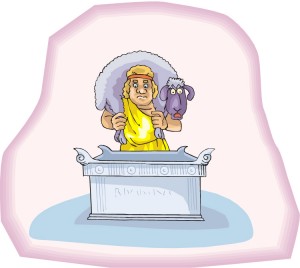Burnt or Elevation (Olah) Offering (Lev 1:3–17)
This offering involved the burning of the entire animal. This was not a partial burning with what remained to be eaten by the priests and/or worshippers. The burning of the animal prophetically pictures the sufferings of Yeshua, the Son of Elohim, for the sins of the world. The burning of the animal was but a faint representation of the punishment that all sinners deserve and that which unrepentant sinners will experience in the lake of fire at the end of the Millennium (Rev 20:11–15). Yeshua took that punishment upon himself at the cross.
Here are some examples of how the burnt offering pointed to Yeshua (and how he fulfilled it):
- The animal sacrificed was a clean or kosher male bull, ram, goat, or pigeon or turtledove, that was without blemish. Similarly, Yeshua was the perfect and proper Lamb of Elohim who was, in his sin-free state, without spiritual defect.
- The owner of the animal was to offer it of his own free will. Messiah willingly offered himself for us.
- It was to be offered at the door of the tabernacle—another picture of Yeshua—where the brazen altar was located, for the sinner was unworthy to enter the tabernacle. This shows that without the shedding of blood—without faith in Yeshua’s shed blood to pay for one’s sins—the sinner can have no communion with YHVH.
- The offerer was to lay his hand upon the head of the animal to be sacrificed signifying a transfer of guilt for sin to the innocent animal, so that now the animal represented himself and was making atonement for him. Redeemed believers must identify with the death, burial and resurrection of Yeshua to have salvation and eternal life (Rom 6:3–14; Gal 2:20; 2 Cor 5:17). It is possible that the significance of the individual offerer laying only one hand upon the offering speaks to the idea that only one sinner was seeking atonement, while the high priest laying both hands on the head of the azazel goat (Lev 16:21) signifies atonement not only for the individual, but for the whole nation (i.e., hands, plural), since the high priest was acting as a representative for the whole nation.
- The animal was to be killed before YHVH signifying that the sinner’s flesh must be crucified with its corrupt affections and lusts. The offerer slaughtered the animal while the priest sprinkled the blood on the altar. The offerer would then skin the animal and wash its parts before giving it to the priest to lay on the altar for it to be totally burned up.
- The priests’ sprinkling the blood upon the altar is significant, for the Scriptures teach us that the life of the animal is in the blood, and that it is the blood that makes an atonement for sin (Lev 17:11). It is Yeshua’s blood shed at the cross when spiritually sprinkled on sinners that atones for their sins.
- The animal was to be divided, laid on the altar and burned. This pictures the intense sufferings of Yeshua prior to and while on the “altar” of the cross.
- This offering was a sweet savor to YHVH, even as the offering of Yeshua was well-pleasing to the Father (Isa 53:10).
- The olah offering could be offered in times of joy, celebration or spiritual rededication (2 Chron 29:20–24) as a gift to express joy and reverence to YHVH (Gen 8:20; 1 Sam 6:14). The olah could also accompany petitions for Elohim’s intervention in time of need (Judg 21:4; Jer 14:12). In all these cases, there is an overriding awareness for the need to give homage and honor to a righteous and set-apart Elohim.


